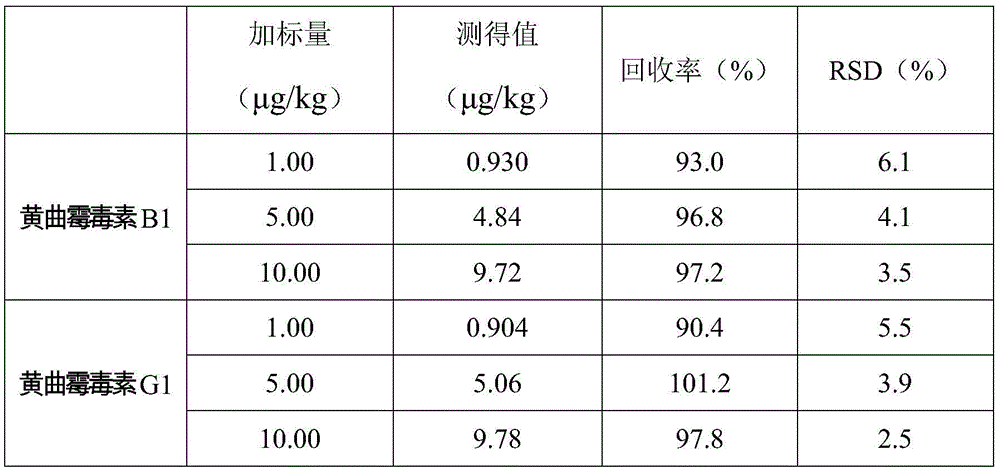Method for high-sensitivity detection of aflatoxin and application of aflatoxin
A technology for sensitive detection of aflatoxins, applied in the field of highly sensitive detection of aflatoxins, can solve problems such as fluorescence instability, and achieve the effects of good fluorescence stability, improved detection sensitivity, and high standard addition recovery.
- Summary
- Abstract
- Description
- Claims
- Application Information
AI Technical Summary
Problems solved by technology
Method used
Image
Examples
Embodiment 1
[0025] Embodiment 1 utilizes the present invention to detect the content of aflatoxin in peanut, and the steps are:
[0026] 1. Take an appropriate amount of aflatoxin reference substance stock solution, dilute it with acetonitrile to obtain aflatoxin B1 and G1 reference substance solutions with concentrations of 0.5, 10, 50, 100, 150, and 200 ng / mL respectively, and add 20% trifluoroacetic acid And after irradiating for 5min under the ultraviolet light, pass through 0.45m organic filter membrane, C18 chromatographic column (4.6mm * 250mm, 5.0 μ m), mobile phase methanol-water (45: 55; v / v), flow velocity 1.0mL / min, The injection volume was 50 μL, and the column temperature was 30°C. The detector is a fluorescence detector with an excitation wavelength of 360nm and an emission wavelength of 440nm; Agilent1200 high performance liquid chromatography (quaternary pump, autosampler, equipped with a fluorescence detector). With the concentration as the abscissa and the peak area as...
Embodiment 2
[0032] Embodiment 2 Utilizes the present invention to detect the content of aflatoxin in corn, and the steps are:
[0033] Sample determination: Accurately weigh 3g of crushed and homogenized corn sample, accurate to 0.0001g, add 30mL of acetonitrile aqueous solution with a volume fraction of 75%, shake vigorously for 1min, ultrasonically extract in a water bath at 50±2°C for 25min, and centrifuge at 4000r / min for 8min , take out the upper layer solution, repeat the extraction 3 times, and combine the supernatant; the derivation conditions and chromatographic conditions are the same as that of Example 1, step 1, and the sample injection detection is carried out, and the content of aflatoxin B1 is 5.41 μg / kg, and the content of aflatoxin G1 is 5.41 μg / kg. The content is 1.49μg / kg.
Embodiment 3
[0034] Embodiment 3 utilizes the present invention to detect the content of aflatoxin in wolfberry, and the steps are:
[0035] Sample determination: Accurately weigh 5g of crushed and homogenized Lycium barbarum sample, accurate to 0.0001g, add 50mL of acetonitrile aqueous solution with a volume fraction of 80%, shake vigorously for 1min, ultrasonically extract in a water bath at 50±2°C for 25min, and centrifuge at 5000r / min for 5min , take out the upper layer solution, repeat the extraction 2 times, and combine the supernatants; the derivation conditions and chromatographic conditions are the same as those in Example 1, step 1, and the sampling detection is carried out, and the content of aflatoxin B1 is 5.41 μg / kg, and the content of aflatoxin G1 The content is 1.49μg / kg.
PUM
 Login to View More
Login to View More Abstract
Description
Claims
Application Information
 Login to View More
Login to View More - R&D
- Intellectual Property
- Life Sciences
- Materials
- Tech Scout
- Unparalleled Data Quality
- Higher Quality Content
- 60% Fewer Hallucinations
Browse by: Latest US Patents, China's latest patents, Technical Efficacy Thesaurus, Application Domain, Technology Topic, Popular Technical Reports.
© 2025 PatSnap. All rights reserved.Legal|Privacy policy|Modern Slavery Act Transparency Statement|Sitemap|About US| Contact US: help@patsnap.com



